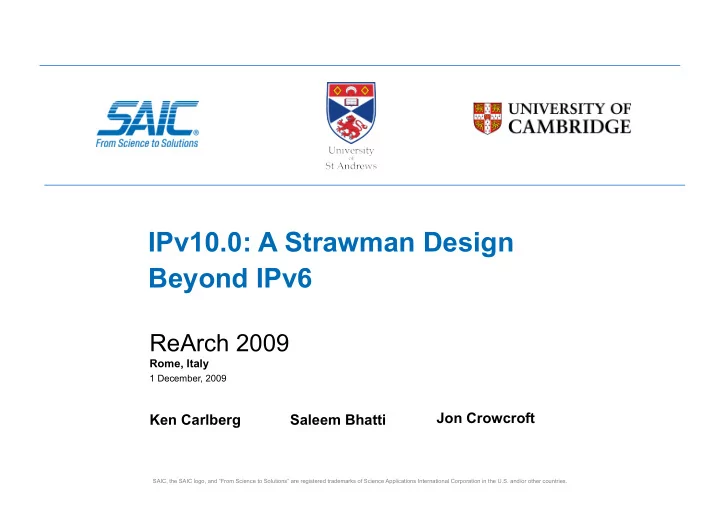

IPv10.0: A Strawman Design Beyond IPv6 ReArch 2009 Rome, Italy 1 December, 2009 Jon Crowcroft Ken Carlberg Saleem Bhatti SAIC, the SAIC logo, and “From Science to Solutions” are registered trademarks of Science Applications International Corporation in the U.S. and/or other countries.
Once upon a time… • The Internet was unknown by the general public • Best Effort was the only game in town • People used Telnet • And brought the need for – Security, more services models, and… 2
Problems with IPv4 • Running out of address space – A/B/C class hierarchy was too inefficient – ’92-’93 estimates of Class-B depletion by 2000 – Near-term solutions: • Class-less Inter-Domain Routing (CIDR) • Network Address Translators (NAT) » Has become the continuing solution • Associated routing table size explosion – Solutions: • New lookup algorithms reduced impact • Faster hardware – Multi-homing has renewed the problem 3
Next Generation IP: Background • Simple IP (or Steve’s IP) – Theme: Minimize header – Add more extensibility (e.g., one or more Next Header) – Flow Identifier (reflected current state-of-the-art work) – Larger flat address structure • The P Internet Protocol (or Paul’s IP) – Change addressing to Locator & Identifier split – Hierarchical and variable length Locator • Implied source routing • The Grand Compromise of ‘94: Simple IP-Plus – Simple IP with hierarchical addresses of Paul’s IP • Becomes IPv6 (RFC-1883) – HOWEVER, in ’98, RFC-2460 removes hierarchical addresses 4
Critique Not much of an architectural change… • Large 128 bit addresses 8 Ver Traffic Class Flow Label Octets – Retains Locator & Identifier Payload Length Next Hdr Hop Limit 16 – Providers still cling to NATs Source Address Octets • No economic incentives to migrate 16 Destination Address Octets • Same size diff-serv field Next Header – Hop-by-Hop � • Multiple Next Headers Next Header - AH � – Only inserted by source • Encapsulation or Multi-Protocol Label Switching (MPLS) is the work-around • End-to-End Flow Labels – “Market” uses island(s) of cut-through routing (e.g., MPLS) • Note: ‘08 report shows IPv6 traffic is 1/100 of 1% of all IP traffic ….Does “more” qualify as an architectural change? ….Where are the “must have” features? 5
Locator / Identifier Split • Four significant discussions in ARPAnet/Internet history – ’77 (TCP and mobility) – ‘92-93 (Paul’s Internet Protocol work), – ‘96 (O’Dell 8+8 proposal), – ’07 (Internet Architecture Board report) • Three Current efforts – Host Identity Protocol (HIP) – Locator/Identifier Separation Protocol (LISP) – Identifier Locator Network Protocol (ILNP) 6
Locator / Identifier Split (cont.) • Multi-Homing problem – Provider Independent prefixes tend to be popular, but are non- aggregable • ILNP Example – Locators are from Internet Service Provider and are always Provider Aggregable Locator-only approach Traditional address approach ISP 1 SBR ¡1 ¡ ISP 1 SBR ¡1 ¡ P.3 + P.1.1 L.3 P.1.1 ¡ L.3.1 ¡ (L.3) (P.3) Site Site Network Network SBR ¡2 ¡ SBR ¡2 ¡ ISP 2 ISP 2 L.4 P.4 + P.2.1 L.4.1 ¡ P.2.1 ¡ (L.4) (P.4) L.x = location P.x = location + identity SBR - Site Border Router ISP - Internet Service Provider 7
IPv10.0 Design • Retain minimalism and extensibility of IPv6 • Incorporate Identifier / Locator Split • Introduce Tails – Change state-insertion model: temporary Headers and Tails ….a starting point for future discussions No No Add local Add local Additions Additions Tail Header IPv10 appended Header/Tail Laptop Laptop Flow Hdr Hdr DATA Tail Security Tail Initial IPv10 packet 8
IPv10.0 Design (cont.) • Header – Header navigation Ver FI Next Hdr Payload Length 12 – Forwarding information Source Locator Octets Destination Locator 8 Ver diff-serv c e Hop Limit Next Tail • Trailer Octets Identification Flag Offset 8 – Trailer navigation Source Identifier Octets – End-to-end information 8 Destination Identifier Octets – Diff-serv Source Initiated Optional Tail ….Non-forwarding information Path Initiated Optional Tail 9
Final Thoughts • Impact of Tails – Change the end-to-end model of constructing headers • Facilitate temporary insertion of overhead information – Avoid inefficient encapsulation – Foster need to go beyond current ASIC header lookup limitation • Should we be more radical in our design? – Are there “must have” features in IPv10.0? 10
Recommend
More recommend